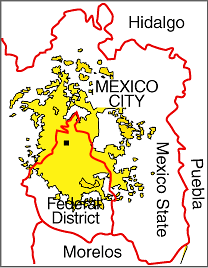A shortage of affordable housing is a persistent problem in large Mexican cities. In response, new, subsidized lower income housing developments are being built on the periphery of Mexico City, Guadalajara, Monterrey, and other metropolitan areas.
Though most working families can afford the down payment and monthly payments for these subsidized housing units, these expenses leave little extra for food, clothing, utility bills, commuting, and health care. Even these subsidized housing units provide a car parking place because virtually all Mexican families aspire to own their own automobile. The case study which follows, of the Hernández family, illustrates the situation.
Carlos Hernández, his spouse, mother-in-law, and two daughters are happy with their house in a new housing development in Zumpango, about 40 km (25 mi) north of the Mexico City Zócalo. The government-backed mortgage on the tiny (30 square meters – 323 square feet, about the size of a two-car garage), 15,700-dollar, one-bedroom house, is 100 dollars a month. Hernández must spend another $110 a month for his daily five hour commute by colectivo (mini bus), bus, and metro (subway) to his $350 a month maintenance job in the capital. This leaves only $140 a month for all other expenses such as food, utilities, installment payments on furniture and appliances, health care, clothing, schooling, etc. To help make ends meet, his spouse, Edith, runs an informal convenience store out of the front of the house.
The house is very crowded; the kitchen table is brought inside only at mealtimes. Carlos and Edith sleep on a foldout couch in the living room. Edith’s mother, Lucía, has the bedroom and the two daughters take turns sleeping with their parents or grandmother. Hernandez is glad he finally owns a house and no longer has to pay rent. His story is repeated tens of thousands of times as hundreds and hundreds of low-income housing developments are being built on the urban periphery.
If you have enjoyed this brief excerpt from chapter 23 of Geo-Mexico: the geography and dynamics of modern Mexico please consider purchasing your own copy of the book. Chapters 21 and 22 analyze Mexico’s 500-year transition to an urban society and the internal geography of Mexico’s cities. Chapter 23 looks at urban issues, problems and trends. To preview more parts of the book, click here and use amazon’s “Look Inside” feature.

Sorry, the comment form is closed at this time.